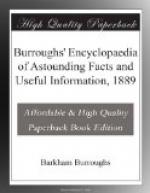Rule.—Divide what the articles cost per dozen by 10. which is done by removing the decimal point one place to the left.
For instance, if hats cost $17.50 per dozen, remove the decimal point one place to the left, making $1.75, what they should be sold for apiece to gain 20 per cent, on the cost. If they cost $31.00 per dozen, they should be sold at $3.10 apiece, etc.
THE SEVEN WONDERS OF THE WORLD.
Pyramids of Egypt.
Tower, Walls and Terrace Hanging Gardens of Babylon.
Statue of Jupiter Olympus, on the Capitoline Hill, at Rome.
Temple of Diana, at Ephesus.
Pharos, or watch-tower, at Alexandria, Egypt.
Colossus of Rhodes, a statue 105 feet high; overthrown by an earthquake 224 B.C.
Mausoleum at Halicarnassus, a Grecian-Persian city in Asia Minor.
HEAT AND COLD.
Degrees of heat above zero at which substances melt:—Wrought iron, 3,980 degrees; cast iron, 3,479; platinum, 3,080; gold, 2,590; copper, 2,548; steel, 2,500; glass, 2,377; brass, 1,900; silver, 1,250; antimony, 951; zinc, 740; lead, 594; tin, 421; arsenic, 365; sulphur, 226; beeswax, 151; gutta percha, 145; tallow, 97; lard, 95; pitch, 91; ice, 33. Degrees of heat above zero at which substances boil:—Ether, 98 degrees; alcohol, 173; water, 212; petroleum, 306; linseed oil, 640; blood heat, 98; eggs hatch, 104.
QUANTITY OF SEED TO AN ACRE.
Wheat, 1-1/2 to 2 bu.; rye, 1-1/2 to 2 bu.; oats, 3 bu.; barley, 2 bu.; buckwheat, 1/2 bu.; corn, broadcast, 4 bu.; corn, in drills, 2 to 3 bu.; corn, in hills, 4 to 8 qts.; broom corn, 1/2 bu.; potatoes, 10 to 15 bu.; rutabagas, 3/4 lbs.; millet, 1/4 bu.; clover, white, 4 qts.; clover, red, 8 qts.; timothy, 6 qts.; orchard grass, 2 qts.; red top, 1 to 2 pks.: blue grass, 2 bu,; mixed lawn grass, 1/2 bu.; tobacco, 2 ozs.
SOLUBLE GLASS FOR FLOORS.
Instead of the old-fashioned method of using wax for polishing floors, etc., soluble glass is now employed to great advantage. For this purpose the floor is first well cleaned, and then the cracks well filled up with a cement of water-glass and powdered chalk or gypsum. Afterward, a water-glass of 60 to 65 , of the thickness of syrup, is applied by means of a stiff brush. Any desired color may be imparted to the floor in a second coat of the water-glass, and additional coats are to be given until the requisite polish is obtained. A still higher finish may be given by pummicing off the last layer, and then putting on a coating of oil.




